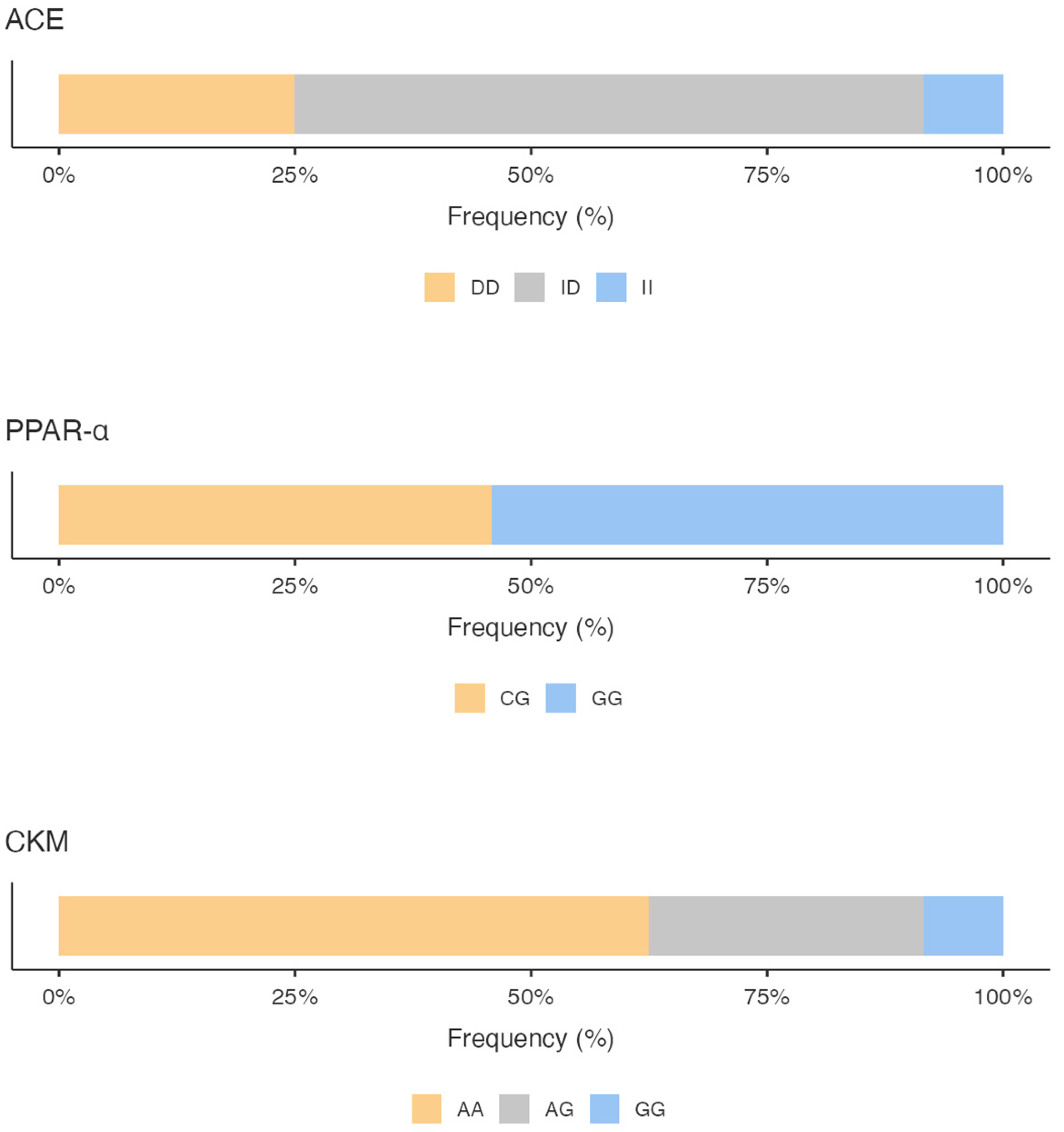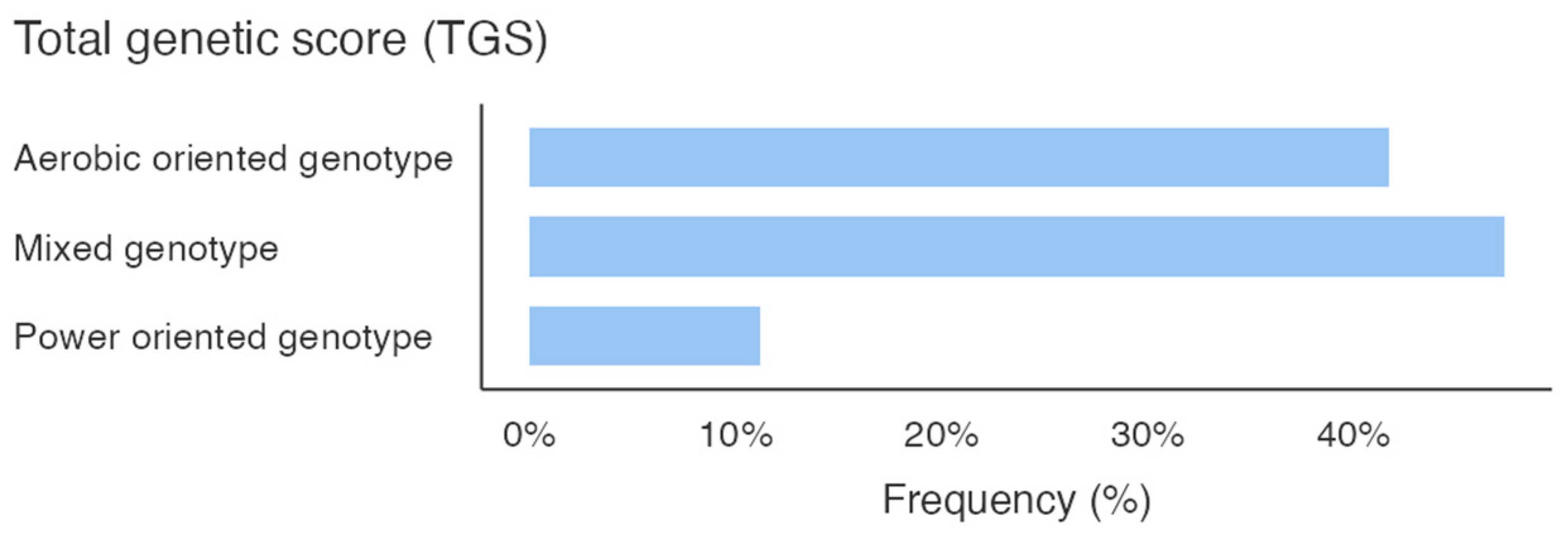Genetic Profiling and Performance Optimization in Elite Combat Sport Athletes: A Cross-Sectional Study Based on Total Genetic Score Analysis
Abstract
:1. Introduction
2. Materials and Methods
2.1. Study Design
2.2. Participants
2.3. Total Genetic Score
2.4. Statistical Analysis
2.5. DNA Extraction and Genotyping
3. Results
4. Discussion
5. Conclusions
Supplementary Materials
Author Contributions
Funding
Institutional Review Board Statement
Informed Consent Statement
Data Availability Statement
Acknowledgments
Conflicts of Interest
References
- Iannaccone, A.; Fusco, A.; Jaime, S.J.; Baldassano, S.; Cooper, J.; Proia, P.; Cortis, C. Stay Home, Stay Active with SuperJump®: A Home-Based Activity to Prevent Sedentary Lifestyle during COVID-19 Outbreak. Sustainability 2020, 12, 10135. [Google Scholar] [CrossRef]
- Amato, A.; Proia, P.; Caldara, G.F.; Alongi, A.; Ferrantelli, V.; Baldassano, S. Analysis of Body Perception, Preworkout Meal Habits and Bone Resorption in Child Gymnasts. Int. J. Environ. Res. Public Health 2021, 18, 2184. [Google Scholar] [CrossRef] [PubMed]
- Widmann, M.; Nieß, A.M.; Munz, B. Physical Exercise and Epigenetic Modifications in Skeletal Muscle. Sports Med. 2019, 49, 509–523. [Google Scholar] [CrossRef]
- Appel, M.; Zentgraf, K.; Krüger, K.; Alack, K. Effects of Genetic Variation on Endurance Performance, Muscle Strength, and Injury Susceptibility in Sports: A Systematic Review. Front. Physiol. 2021, 12, 694411. [Google Scholar] [CrossRef] [PubMed]
- Varillas-Delgado, D.; Del Coso, J.; Gutiérrez-Hellín, J.; Aguilar-Navarro, M.; Muñoz, A.; Maestro, A.; Morencos, E. Genetics and sports performance: The present and future in the identification of talent for sports based on DNA testing. Eur. J. Appl. Physiol. 2022, 122, 1811–1830. [Google Scholar] [CrossRef]
- Ahmetov, I.I.; Hall, E.C.R.; Semenova, E.A.; Pranckevičienė, E.; Ginevičienė, V. Advances in sports genomics. Adv. Clin. Chem. 2022, 107, 215–263. [Google Scholar] [PubMed]
- Amato, A.; Messina, G.; Contro, V.; Sacco, A.; Proia, P. Total genetic score: An instrument to improve the performance in the elite athletes. Acta Medica Mediterr. 2018, 34, 1857–1862. [Google Scholar]
- Jones, N.; Kiely, J.; Suraci, B.; Collins, D.; de Lorenzo, D.; Pickering, C.; Grimaldi, K. A genetic-based algorithm for personalized resistance training. Biol. Sport 2016, 33, 117–126. [Google Scholar] [CrossRef]
- Chiu, Y.H.; Lai, J.I.; Tseng, C.Y.; Wang, S.H.; Li, L.H.; Kao, W.F.; How, C.K.; Chang, W.H.; Hsieh, C.Y. Impact of angiotension I converting enzyme gene I/D polymorphism on running performance, lipid, and biochemical parameters in ultra-marathoners. Medicine 2019, 98, e16476. [Google Scholar] [CrossRef]
- Balberova, O.V.; Bykov, E.V.; Medvedev, G.V.; Zhogina, M.A.; Petrov, K.V.; Petrova, M.M.; Al-Zamil, M.; Trefilova, V.V.; Goncharova, P.S.; Shnayder, N.A. Candidate Genes of Regulation of Skeletal Muscle Energy Metabolism in Athletes. Genes 2021, 12, 1682. [Google Scholar] [CrossRef]
- Kowalski, T.; Rębiś, K.; Malczewska-Lenczowska, J.; Klusiewicz, A.; Starczewski, M.; Klich, S.; Kasiak, P. Optimizing Recovery Strategies in Elite Speedskating: A Comparative Analysis of Different Modalities. J. Funct. Morphol. Kinesiol. 2025, 10, 34. [Google Scholar] [CrossRef] [PubMed]
- Kurtuluş, M.; Keskin, K.; Gunay, M.; Kesici, T.; Gökdemir, K. Genetic differences in peroxisome proliferator-activated receptor alpha gene in endurance athletes (long distance runners) and power/endurance athletes (wrestlers, football players). J. Basic Clin. Health Sci. 2023, 7, 723–730. [Google Scholar] [CrossRef]
- Fedotovskaya, O.; Eider, J.; Cięszczyk, P.; Ahmetov, I.; Moska, W.; Sawczyn, S.; Ficek, K.; Leońska-Duniec, A.; Maciejewska-Karłowska, A.; Sawczuk, M.; et al. Association of muscle-specific creatine kinase (CKM) gene polymorphism with combat athlete status in Polish and Russian cohorts. Arch. Budo 2013, 3, 233–237. [Google Scholar]
- Batavani, M.R.; Marandi, S.M.; Ghaedi, K.; Esfarjani, F. Comparison of muscle-specific creatine kinase (CK-MM) gene polymorphism (rs8111989) among professional, amateur athletes and non-athlete karatekas. Asian J. Sports Med. 2017, 8, e43210. [Google Scholar] [CrossRef]
- Petr, M.; Št‘astný, P.; Pecha, O.; Šteffl, M.; Šeda, O.; Kohlíková, E. PPARA intron polymorphism associated with power performance in 30-s anaerobic Wingate Test. PLoS ONE 2014, 9, e107171. [Google Scholar] [CrossRef]
- Ahmetov, I.I.; Mozhayskaya, I.A.; Flavell, D.M.; Astratenkova, I.V.; Komkova, A.I.; Lyubaeva, E.V.; Tarakin, P.P.; Shenkman, B.S.; Vdovina, A.B.; Netreba, A.I.; et al. PPARα gene variation and physical performance in Russian athletes. Eur. J. Appl. Physiol. 2006, 97, 103–108. [Google Scholar] [CrossRef]
- Vostrikova, A.; Pechenkina, V.; Danilova, M.; Boronnikova, S.; Kalendar, R. Gene polymorphism and total genetic score in martial arts athletes with different athletic qualifications. Genes 2022, 13, 1677. [Google Scholar] [CrossRef]
- Anastasiou, K.; Morris, M.; Akam, L.; Mastana, S. The Genetic Profile of Combat Sport Athletes: A Systematic Review of Physiological, Psychological and Injury Risk Determinants. Int. J. Environ. Res. Public Health 2024, 21, 1019. [Google Scholar] [CrossRef]
- Cerit, M.; Erdoğan, M.; Oral, O. Association Between the ACE I/D Gene Polymorphism and Comparison of 3000m Running Performance With and Without Equipment During the Basic Military Training. Int. J. Appl. Exerc. Physiol. 2019, 8, 799–806. [Google Scholar]
- Kahya, S.; Taheri, M. Exploring the nexus between sports performance and genetics: A comprehensive literature review: Sports and genetics. Cell. Mol. Biol. 2024, 70, 275–283. [Google Scholar] [CrossRef]
- Eynon, N.; Ruiz, J.R.; Femia, P.; Pushkarev, V.P.; Cieszczyk, P.; Maciejewska-Karlowska, A.; Sawczuk, M.; Dyatlov, D.A.; Lekontsev, E.V.; Kulikov, L.M.; et al. The ACTN3 R577X polymorphism across three groups of elite male European athletes. PLoS ONE 2012, 7, e43132. [Google Scholar] [CrossRef] [PubMed]
- Bell, J.T.; Tsai, P.C.; Yang, T.P.; Pidsley, R.; Nisbet, J.; Glass, D.; Mangino, M.; Zhai, G.; Zhang, F.; Valdes, A.; et al. Epigenome-wide scans identify differentially methylated regions for age and age-related phenotypes in a healthy ageing population. PLoS Genet 2012, 8, e1002629. [Google Scholar] [CrossRef]
- Gunel, T.; Gumusoglu, E.; Hosseini, M.K.; Yilmazyildirim, E.; Dolekcap, I.; Aydinli, K. Effect of angiotensin I-converting enzyme and α-actinin-3 gene polymorphisms on sport performance. Mol. Med. Rep. 2014, 9, 1422–1426. [Google Scholar] [CrossRef] [PubMed]
- Ruiz, J.R.; Arteta, D.; Buxens, A.; Artieda, M.; Gómez-Gallego, F.; Santiago, C.; Yvert, T.; Morán, M.; Lucia, A. Can we identify a power-oriented polygenic profile? J. Appl. Physiol. 2010, 108, 561–566. [Google Scholar] [CrossRef]
- Liguori, G.; Feito, Y.; Fountaine, C.; Roy, B.A. ACSM’s Guidelines for Exercise Testing and Prescription; Lippincott Williams & Wilkins: Philadelphia, PA, USA, 2020. [Google Scholar]
- Homma, H.; Saito, M.; Saito, A.; Kozuma, A.; Matsumoto, R.; Matsumoto, S.; Kobatake, N.; Okamoto, T.; Nakazato, K.; Nishiyama, T.; et al. The Association between Total Genotype Score and Athletic Performance in Weightlifters. Genes 2022, 13, 2091. [Google Scholar] [CrossRef]
- Hughes, D.C.; Day, S.H.; Ahmetov, I.I.; Williams, A.G. Genetics of muscle strength and power: Polygenic profile similarity limits skeletal muscle performance. J. Sports Sci. 2011, 29, 1425–1434. [Google Scholar] [CrossRef]
- Amato, A.; Sacco, A.; Macchiarella, A.; Contrò, V.; Sabatino, E.; Galassi, C.; Proia, P. Influence of nutrition and genetics on performance: A pilot study in a group of gymnasts. Hum. Mov. 2017, 18, 12–16. [Google Scholar] [CrossRef]
- Küchler, E.C.; Tannure, P.N.; Falagan-Lotsch, P.; Lopes, T.S.; Granjeiro, J.M.; Amorim, L.M. Buccal cells DNA extraction to obtain high quality human genomic DNA suitable for polymorphism genotyping by PCR-RFLP and Real-Time PCR. J. Appl. Oral. Sci. 2012, 20, 467–471. [Google Scholar] [CrossRef]
- John, R.; Dhillon, M.S.; Dhillon, S. Genetics and the Elite Athlete: Our Understanding in 2020. Indian J. Orthop. 2020, 54, 256–263. [Google Scholar] [CrossRef]
- Kumari, N.; Ahirwar, R.; Yadav, A.; Ramakrishnan, L.; Sagar, S.K.; Mondal, P.R. ACE Gene I/D Polymorphism and Cardiometabolic Risk Factors: A Cross Sectional Study of Rural Population. Biochem. Genet. 2024, 62, 1008–1020. [Google Scholar] [CrossRef]
- Albuquerque, M.R.; Cunha, A.E.D.S.; Ferreira de Araújo, J.L.; Guimarães, R.D.S.; Rocha, M.R.C.C.; Mesquita, P.H.; Pimenta, E.M.; Pedra de Souza, R. Relative Age Effect and ACTN3 R577X and ACE I/D Polymorphisms in Brazilian Football Players: An Association Genetic Study. Res. Q. Exerc. Sport 2024, 1–11. [Google Scholar] [CrossRef] [PubMed]
- Cocci, P.; Pistolesi, L.; Guercioni, M.; Belli, L.; Carli, D.; Palermo, F.A. Genetic variants and mixed sport disciplines: A comparison among soccer, combat and motorcycle athletes. Ann. Appl. Sport Sci. 2019, 7, 1–9. [Google Scholar] [CrossRef]


| Characteristics | Mean ± SD |
|---|---|
| Age (years) | 22.1 ± 5.8 |
| Body mass (kg) | 66.1 ± 15.4 |
| Body height (cm) | 173.0 ± 9.5 |
| BMI (kg·m−2) | 21.8 ± 3.2 |
| Gene | Polymorphism | GS Power Oriented | Involved Metabolism |
|---|---|---|---|
| ACE | DD | 2 | Anaeorobic |
| ID | 1 | Anaerobic/Aerobic | |
| II | 0 | Aerobic | |
| PPARα | CC | 2 | Anaeorobic |
| CG | 1 | Anaerobic/Aerobic | |
| GG | 0 | Aerobic | |
| CKM | GG | 2 | Anaeorobic |
| AG | 1 | Anaerobic/Aerobic | |
| AA | 0 | Aerobic |
| Gene | Primers Sequence | Denaturation | Annealing | Extension | Cycles |
|---|---|---|---|---|---|
| ACE | F:5′GCCCTGCAGGTGTCTGCAGCATGT3′ | 94°30′′ | 56°45′′ | 72°1′ | 35 |
| R:5′GGATGGCTCTCCCCGCCTTGTCTC3′ | |||||
| PPARα | F:5′ACAATCACTCCTTAAATATGGTGG3′ | 94°30′′ | 59°30′′ | 72°30′′ | 35 |
| R:5′AAGTAGGGACAGACAGGACCAGTA3′ | |||||
| CKM | F:5′GGGATGCTCAGACTCACAGA3′ | 94°40′′ | 53°45′′ | 72°1′ | 30 |
| R:5′AACTTGAATTTAGCCCAACG3′ |
| Gene | Restriction Enzyme | Digestion | Polymorphism | Fragment Lenght |
|---|---|---|---|---|
| ACE | Not required | - | DD | 319 bp |
| II | 597 bp | |||
| ID | 319 + 597 bp | |||
| PPARα | TAQ I | 65° | CC | 216 + 50 bp |
| 2:30 h | GG | 266 bp | ||
| CG | 266 + 216 + 50 bp | |||
| CKM | NCO I | 37° | GG | 359 bp |
| 2:30 h | AA | 206 + 153 bp | ||
| AG | 359 + 206 + 153 bp |
Disclaimer/Publisher’s Note: The statements, opinions and data contained in all publications are solely those of the individual author(s) and contributor(s) and not of MDPI and/or the editor(s). MDPI and/or the editor(s) disclaim responsibility for any injury to people or property resulting from any ideas, methods, instructions or products referred to in the content. |
© 2025 by the authors. Licensee MDPI, Basel, Switzerland. This article is an open access article distributed under the terms and conditions of the Creative Commons Attribution (CC BY) license (https://creativecommons.org/licenses/by/4.0/).
Share and Cite
Pagliaro, A.; Alioto, A.; Boatta, A.; Messina, G.; Drid, P.; Milazzo, P.; Cortis, C.; Fusco, A.; Vasto, S.; Proia, P.; et al. Genetic Profiling and Performance Optimization in Elite Combat Sport Athletes: A Cross-Sectional Study Based on Total Genetic Score Analysis. Genes 2025, 16, 461. https://doi.org/10.3390/genes16040461
Pagliaro A, Alioto A, Boatta A, Messina G, Drid P, Milazzo P, Cortis C, Fusco A, Vasto S, Proia P, et al. Genetic Profiling and Performance Optimization in Elite Combat Sport Athletes: A Cross-Sectional Study Based on Total Genetic Score Analysis. Genes. 2025; 16(4):461. https://doi.org/10.3390/genes16040461
Chicago/Turabian StylePagliaro, Andrea, Anna Alioto, Alessia Boatta, Giuseppe Messina, Patrik Drid, Paolo Milazzo, Cristina Cortis, Andrea Fusco, Sonya Vasto, Patrizia Proia, and et al. 2025. "Genetic Profiling and Performance Optimization in Elite Combat Sport Athletes: A Cross-Sectional Study Based on Total Genetic Score Analysis" Genes 16, no. 4: 461. https://doi.org/10.3390/genes16040461
APA StylePagliaro, A., Alioto, A., Boatta, A., Messina, G., Drid, P., Milazzo, P., Cortis, C., Fusco, A., Vasto, S., Proia, P., & Baldassano, S. (2025). Genetic Profiling and Performance Optimization in Elite Combat Sport Athletes: A Cross-Sectional Study Based on Total Genetic Score Analysis. Genes, 16(4), 461. https://doi.org/10.3390/genes16040461












